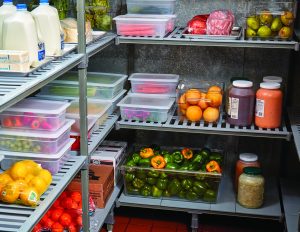Nothing sends a chill through a commercial kitchen like a bout of food poisoning. Salmonella or E.coli not only makes us sick but can damage the reputation, brand and customer base of your establishment.
Why is commercial food storage so important?
There’s more to keeping hot food hot and cold food cold. Preventing food from going ‘off’ keeps it nutritious, safe and saves your business money.
“Food poisoning microorganisms grow really well at temperatures between 5°C and 60°C which we called Temperature Danger Zone,” says Agriculture and Food lecturer Senaka Ranadheera, at the University of Melbourne.
“Dry foods can be stored around 10°C to 15°C, but potentially hazardous foods such as seafood, meat and dairy need either refrigeration or frozen storage”.
Commercial Food Storage at Room Temperature
Keeping commercial food storage areas clean and dry reduces the spread of bacteria and other microorganisms. Fungal spores thrive in moist, humid conditions and rapidly spoil food.
Insects, rodents and bird infestation can be avoided by using clear food storage containers with tight-fitting reusable lids. Sweeping up spillages and sealing cracks and crevices in walls can further reduce visits by the local pest controller.
Shelving can reduce overcrowding and keeps food off the floor, so the area can be regularly cleaned. Make sure cleaning products and personal belongings are kept in a separate area.
Storing chilled food
Some foods require storage at temperatures colder than 5°C. This prevents bacteria from multiplying and spoiling the food. A digital probe thermometer or infra-red thermometer can double-check the food temperature is just right.
“Refrigerated food should not be repeatedly taken out and put back in storage unnecessarily. But, if you don’t properly plan, it’s a bit difficult to maintain in a restaurant environment,” says Ranadheera.
The fridge needs to be regularly cleaned to prevent the transfer of bacteria and mould. Regular servicing and preventing the fridge from overcrowding will keep the air circulation at the right temperature. Dunnage racks can raise food off the floor while maintaining air circulation.
Store food in clean, sanitised containers with lids that seal well. Otherwise, you can wrap food
in a protective covering. Clearly label and date the containers so they’re easily identified, so stock can be rotated on a ‘first in, first out’ basis.
Raw meat and eggs often get the blame for food poisoning, and for good reason. Make sure all raw meats (including chicken and seafood) and raw eggs are stored separately and below the ‘ready to eat’ foods in the fridge.

Storing food in the freezer
Most bacteria can’t grow or multiply below -18°C. That’s why raw meats and other perishable foods can be stored at this temperature for such a long time.
Label and date all food in sanitised, clear and tight sealing containers and make sure the food is frozen solid. Partially frozen food needs to be moved to the fridge and never thaw food at room temperature. Once thawed, the food must be consumed within 24 hours.
Food also loses its quality the longer it’s frozen. Vacuum packaging can minimise its exposure to air, reducing the risk of freezer burn.
Shelving or dunnage racks can be used to keep the food off the floor and help with air circulation.


















